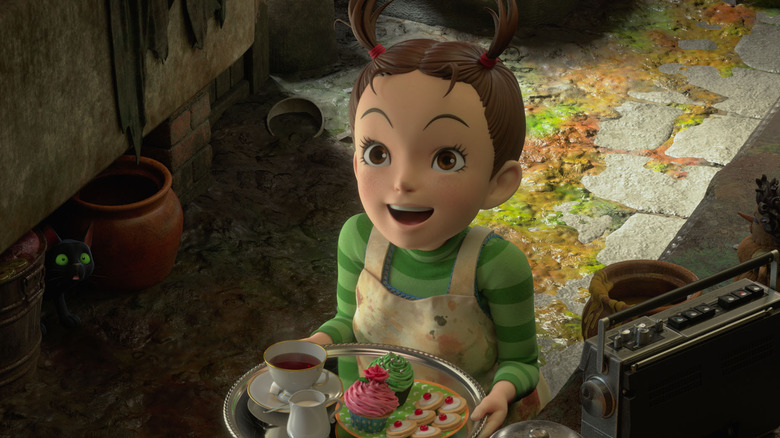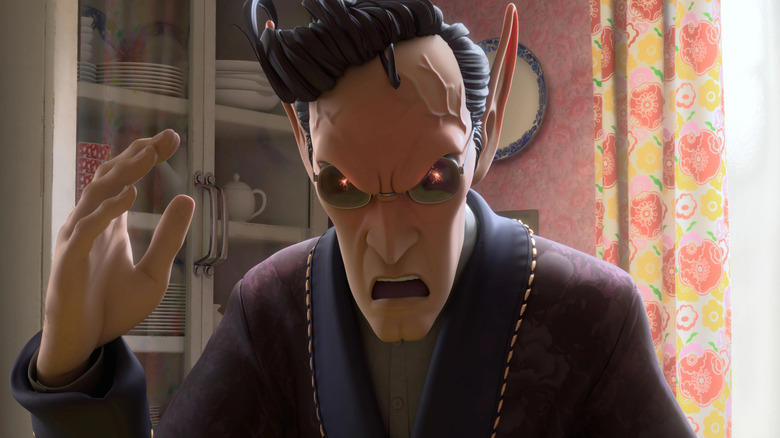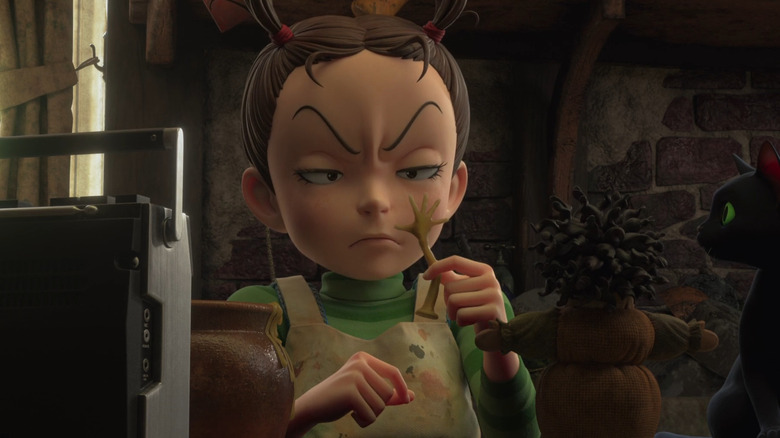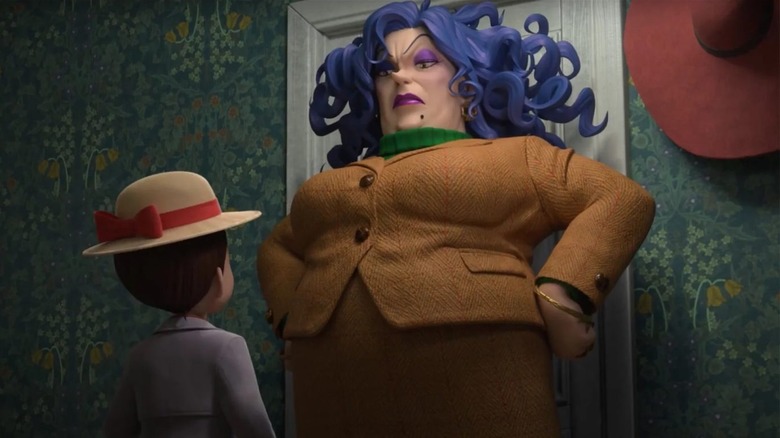Why Studio Ghibli Went CGI For Earwig And The Witch
Goro Miyazaki's film "Earwig and the Witch" is a notable oddity in the Studio Ghibli catalogue, mainly for its medium. Ghibli became famous for its hand-drawn style, and it remained a traditional cel animation studio up until 2020. "Earwig" was the first Ghibli film to be made entirely using CGI, offering a drastic visual departure from their usual fare, offering sphere-headed characters, wiry 3D hair, and detailed and textured backgrounds. The look was infamously rejected by most audiences, with most critics citing "Earwig" as a lackluster effort from a studio known for its stellar track record.
Based on the novel by Diana Wynne Jones, "Earwig and the Witch" is about the world's brattiest orphan, Earwig, who hopes to never be adopted; she has already arranged the orphanage according to her Eloise-like whims and enjoys being in control. Earwig is, however, adopted by a witch, and is taken back to the witch's house to aid in the making of mundane potions for a dwindling clientele. Eventually Earwig will, in her own way, bring the witch to heel, learn to express agency, and find her adopted mother had a rockin' connection to her birth mother. There's a lot of mud, mold, and slime, and Earwig is delightfully caustic, no gentle moppet. While certainly unlike other films in the Ghibli canon, "Earwig" is still appealingly peculiar with an unusual story and strange characters.
In a 2020 interview with The Verge, Miyazaki explained why he went with CGI to make "Earwig," as well as the limitations of hand-drawn animating. It turns out, this style of animation didn't capture the kind of look he wanted, and it simply took too much time and effort.
Stop-motion inspiration
In the Verge interview, Goro Miyazaki says he struck upon the desired "Earwig" visual in thinking not about the previous films from Ghibli (largely directed by either Isao Takahata or Miyazaki's father, Hayao), but the look and feel of stop-motion animation. In employing dolls or maquettes, the style is bound by the limits of the model built; a stop-motion character is like a puppet in many ways. This is often the case with CGI as well, with the characters bound by their design. Miyazaki started to think of the world in those terms, and the aesthetic began to emerge:
" In terms of the visuals, this being the first 3D CG anime from Studio Ghibli ... Studio Ghibli has always done hand-drawn-style animation, so we knew that we weren't able to recreate that through 3D CG, so it was a matter of which direction we wanted to go with. Whether it's going to be a very photorealistic visual, or trying to find a different path. That was when I referenced stop-motion animation, using a lot of puppets. I felt that was quite fitting for what we were trying to do with this project. I referenced that a lot in creating the visuals."
Given some of the more recent, high-profile stop-motion animated features released in theaters, "Earwig and the Witch" feels of a piece. Scary horror movies tend to employ the medium well, and the last decade has seen films like "Coraline," Tim Burton's "Corpse Bride" and "Frankenweenie," and the Dickensian "The Boxtrolls" grace screens. That's not to mention Halloween classics like "Mad Monster Party?" and "The Nightmare Before Christmas." "Earwig" was clearly harkening to an established subgenre.
The consistency of the hand
Goro Miyazaki was concerned with efficiency when it came to character work. The traditional approach to character animation is to have a team of animators each assigned to each character, and it is their job to perfect only that character. Looking over the credits of an older animated feature from Disney will reveal each character broken out in such a way. Miyazaki felt character work could be traded hands more easily when the baseline model exists in a computer:
"One of the things I found was that with hand-drawn animation, you have to rely on the hands of a very talented animator to bring out a great performance from the character with facial expressions, emotions, and so forth. There's a limited number of very talented animators that can do so. That's one of the big challenges with hand-drawn animation. But with 3D CG, you're able to have different people working on different expressions of one character, which worked well for us."
It is more difficult to go "off model" with CGI (that is: allow the characters to stretch and distort beyond what has been drawn on an preapproved character model sheet). As Ghibli films aren't the type to go off model much anyway — Takahata is a far cry from Bob Clampett — CGI wasn't wholly inappropriate.
Environs
Another issue Goro Miyazaki had with traditional hand-drawn animation was its lack of consistency. He wanted a very detailed world, and he knew the line mileage of drawing such backgrounds over and over again would not only be time-consuming, but lead to visual continuity errors. It's notable that much of "Earwig" takes place in a small house in the same few rooms, making inconsistencies potentially stand out even more. Miyazaki continued to The Verge:
"The original story is about the girl being confined in that house, and dealing with the witch she lives with. However, what we did was, because there are limited locations, we wanted to make sure that each set was high quality, that it was very rich in details. If you think about trying to recreate that with hand-drawn animation, the art department would go crazy because it would mean they would have to redraw all of that clutter and small details a million times. In that sense, the 3D CG approach really worked."
Given the critical rejection of "Earwig and the Witch," one may begin to view it as a daring but failed aesthetic exercise. Could a Studio Ghibli film be made in CGI? As it turns out, yes, but not in a way the studio's fan appreciate. There were even rumors that Miyazaki's famous father found "Earwig" to be abominable, but the rumors were quelled in a SoraNews interview in 2021. As it stands, "Earwig" is puckish, weird, and unlike anything from studio's past. Perhaps it is time for a larger reassessment.
"Earwig and the Witch" is streaming on HBO Max.



